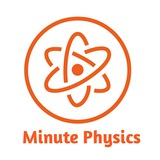Supermassive Black Holes May Have Formed Without Any Stars.
Stellar-mass black holes, which are formed by stars going supernova, weigh between a few and a few dozen times the mass of the Sun. At the center of galaxies, however, there are supermassive black holes weighing millions, if not billions, of times the mass of our Sun. For a long time, astronomers believed that these supermassive black hole grew slowly but in recent years, observations have shown that these giants were already in place and massive long before the first stars formed.
Researchers trying to wrap their heads around these objects' formations have considered quite a few scenarios. Now a paper published in The Astrophysical Journal Letters combines some of those ideas, suggesting that these primordial black holes may have collapsed from a very large cloud of gas that, given the gravity and short time-scale, had no time to break apart and turn into stars. These are called direct-collapse black holes.
@MinutePhysics
Powered By: Curiosity Tea
Stellar-mass black holes, which are formed by stars going supernova, weigh between a few and a few dozen times the mass of the Sun. At the center of galaxies, however, there are supermassive black holes weighing millions, if not billions, of times the mass of our Sun. For a long time, astronomers believed that these supermassive black hole grew slowly but in recent years, observations have shown that these giants were already in place and massive long before the first stars formed.
Researchers trying to wrap their heads around these objects' formations have considered quite a few scenarios. Now a paper published in The Astrophysical Journal Letters combines some of those ideas, suggesting that these primordial black holes may have collapsed from a very large cloud of gas that, given the gravity and short time-scale, had no time to break apart and turn into stars. These are called direct-collapse black holes.
@MinutePhysics
Powered By: Curiosity Tea
Do you know?
On average, the sun rotates on its axis once every 27 days. However, its equator spins the fastest and takes about 24 days to rotate, while the poles take more than 30 days. The inner parts of the sun also spin faster than the outer layers, according to NASA.
@MinutePhysics
Powered By: Curiosity Tea
On average, the sun rotates on its axis once every 27 days. However, its equator spins the fastest and takes about 24 days to rotate, while the poles take more than 30 days. The inner parts of the sun also spin faster than the outer layers, according to NASA.
@MinutePhysics
Powered By: Curiosity Tea
Minute Physics via @like
This media is not supported in your browser
VIEW IN TELEGRAM
Do you know the science behind this?
Yes 🙃
Nope 🤔
Yes 🙃
Nope 🤔
Minute Physics via @like
Do you know the science behind this? Yes 🙃 Nope 🤔
The seventh largest man made lake in California is held by the 304 foot tall Monticello Dam and is home to famous “Glory Hole” spillway. The spillway is the funnel shape at the opening it measures 72 feet across becoming narrowing down to aprox 28 feet as it drops down 200 vertical feet.
It’s objective is to drain out the water when the lake is filled to maximum. The water on drained out to the other side of the dam directly into Putah Creek.
This video was recorded by a drone when the spillway was in action on 16th feb 2017.
@MinutePhysics
Powered By: Curiosity Tea
It’s objective is to drain out the water when the lake is filled to maximum. The water on drained out to the other side of the dam directly into Putah Creek.
This video was recorded by a drone when the spillway was in action on 16th feb 2017.
@MinutePhysics
Powered By: Curiosity Tea
Minute Physics via @like
You're Almost Completely Made Up of Empty Space. ... In fact, 99.9999999 percent of all of the matter around us is empty space. That means if you took the empty space out of every human on earth, you could compress the entire human population down to an object smaller than a sugar cube.
@MinutePhysics
@MinutePhysics
A skyhook is a proposed momentum exchange tether that aims to reduce the cost of placing payloads into low Earth orbit. A heavy orbiting station is connected to a cable which extends down towards the upper atmosphere.
@MinutePhysics
Powered By: Curiosity Tea
@MinutePhysics
Powered By: Curiosity Tea
Water can boil and freeze at the same time.
Seriously, it's called the 'triple point, and it occurs when the temperature and pressure is just right for the three phases (gas, liquid, and solid) of a substance to coexist in thermodynamic equilibrium.
@MinutePhysics
Powered By: Curiosity Tea
Seriously, it's called the 'triple point, and it occurs when the temperature and pressure is just right for the three phases (gas, liquid, and solid) of a substance to coexist in thermodynamic equilibrium.
@MinutePhysics
Powered By: Curiosity Tea
Minute Physics via @like
Light is affected by gravity but not directly. Gravity affects objects which have some mass but light particles do not have any mass so gravity cannot affect it directly. But it affects the space-time continuum in which light travels.
@MinutePhysics
Powered By: Curiosity Tea
@MinutePhysics
Powered By: Curiosity Tea
When two metals touch in space, they can fuse together without the need for an open flame. Why? Because metals have both positively moving ions in a "sea" of negatively moving electrons. Without oxygen in space, the oxide layer over the metals disappears. Just add a little bit of force and the metals can fuse together.
@MinutePhysics
Powered By: Curiosity Tea
@MinutePhysics
Powered By: Curiosity Tea
